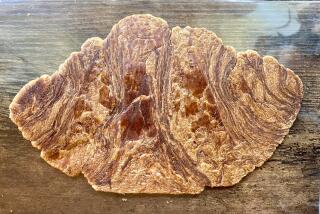Le Pancake
- Share via
Fifteen years ago, a French tourist guidebook expressed shock at the American idea of breakfast: “Their crepes are over a centimeter thick!” This was almost more horrifying to the writer than what we put on our “crepes,” a syrup made from tree sap.
The French writer should really get out more. Many of the world’s pancakes are thicker and, well, more cake-like than a French crepe. Crepe-like pancakes are mostly used for wrapping stuff in; pancakes eaten by themselves tend to be thick.
Pancakes are made from batter, rather than from a kneaded dough with a good gluten structure, so they often have eggs mixed in to keep them from falling apart as they fry. Possibly because eggs didn’t often come their way, medieval Central Asian nomads made a pancake called chalpak by kneading dough and then laboriously mixing in more water to get a sort of glutinous batter.
Thicker pancakes have usually been made with yeasted batter. The Gold Rush miners who lived on bacon, coffee and sourdough flapjacks were following an old tradition.
However, Americans have always been impatient, and about 200 years ago we invented baking soda for instant leavening. Hence the buttermilk pancake; buttermilk provided the acidity to make the baking soda work.
But even that was too inconvenient, so we invented baking powder. The first flour sold with baking powder already mixed in appeared in 1889 under the brand name Aunt Jemima. A woman named Nancy Green was hired to be Aunt Jemima (making her possibly the world’s first spokesmodel) and served more than a million pancakes to visitors to the Chicago World’s Fair. She toured the country for the next 30 years.
By the way, the reason foreign pancakes never taste quite right to us is that we Americans are the only people who always put a dash of corn meal in our pancake batter.
More to Read
Sign up for The Wild
We’ll help you find the best places to hike, bike and run, as well as the perfect silent spots for meditation and yoga.
You may occasionally receive promotional content from the Los Angeles Times.






